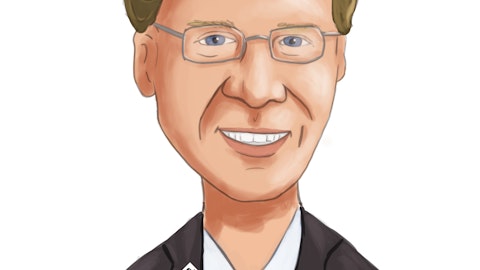Philip Mantua: Yes, Russell, good question. And so the technology piece as it relates to what’s coming on board here in the fourth quarter as we put things into motion is probably on a run rate basis about $1 million quarter-to-quarter and then with — in addition to that in the fourth quarter there are costs of just doing this that that initial kickoff which is probably worth another $0.5 million. That part shouldn’t reoccur. But the cost that’s related to just the ongoing element of bringing that what’s been on a CapEx basis into the run rate is probably about $1 million into the fourth quarter and beyond. And then from that point on, looking at the inflationary piece as well is where we guided towards that 3% to 4% into year-over-year relative to 2024 and 2023. So that’s been taken into consideration.
Russell Gunther: Okay, great. Thank you, Phil. That’s it from me guys. Thanks for taking my questions.
Philip Mantua: Sure.
Daniel Schrider: Sure. Thanks, Russell.
Operator: Our next question comes from Casey Whitman of Piper Sandler. Casey, please go ahead.
Casey Whitman: Hey, good afternoon.
Daniel Schrider: Good afternoon.
Philip Mantua: Good afternoon, Casey.
Casey Whitman: Just going back to the margin, maybe if we just switch gears to the asset side, first can you kind of ballpark where new loan production is coming on or where it was in the month of September?
Philip Mantua: Yes, I’d be glad to. So overall commercial pricing the average yield on all production during the month of September was around 8 in the quarter and it has been at that level for a couple of months here and so we would anticipate, again given that we want to price appropriately for the growth or the production that we are willing to take on, would like to see it in that same vein and with that about 80% to 85% of that production at those levels was variable or floating rate in nature.
Casey Whitman: Okay. And so maybe can you walk us through sort of the quarterly repricing we can expect to see on the loan side just in a static rate environment to get to sort of your margin expectations for 2024?
Philip Mantua: Yes. So on the asset side, it relates to the, to what would help feed that 5 to 7 basis points to the margin. On the loan side, it would probably be, if we look into the fourth quarter and beyond we probably see a pickup of about 8 to 10 basis points in the next quarter and then probably similar to the margin, 5 to 7 basis points on a quarter by quarter basis.
Casey Whitman: All right. And then switching gears, just as the environment may stabilize in a bit and just given your growth outlook, what’s your current appetite for buybacks at the stock price or what would it take for you to get more aggressive there?
Daniel Schrider: Yes, Casey, this is Dan. I think we mentioned the last time we continue to have an authorization out there and it’s probably more a function of looking for the next couple of quarters and making sure we feel as confident as we do today with regard to the credit environment. So I would say sitting here at the moment just make — there’s a lot of uncertainty out there. It’s become more uncertain with world events and so I think capital is pretty important, but we could feel different in the short run and be active particularly at where we’re trading right now.
Casey Whitman: Understood. And just going back, this is just thinking about the loan deposit ratio, obviously, that came down this quarter. But do you have a spot where you’re kind of comfortable with that running, and how does that kind of play into the outlook, the loan growth outlook?
Philip Mantua: Yes, Casey, this is Phil. I think we’re very comfortable right where we are today, hovering around 100%. I think as we move forward in time and not any time being immediately thereafter, we would probably want to manage it further down into the mid 90% range, but again, not any quarter in the more current couple of quarters out. So, I think you would probably expect with what we were just talking about, margin wise and otherwise, to see it staying around kind of around 100% level.
Casey Whitman: Okay, makes sense. Thank you.
Philip Mantua: You’re welcome.
Daniel Schrider: Thanks, Casey.
Operator: Our next question comes from Catherine Mealor of KBW. Catherine, the line is yours.
Catherine Mealor: Thanks. I just wanted to ask a quick clarifying question on the expense guide you gave Dan. So when you said 3% to 4% growth in 2024 for 2023, I thought you said it included the pension expense? Or did you mean that off of an operating expense number?
Daniel Schrider: Yes, I was netting out the pension expense number.
Catherine Mealor: Great. Okay, so take that out, and then…
Daniel Schrider: Yes.
Catherine Mealor: That’s all right. No, I didn’t want to grow it up with a 275 number. Okay, great.
Philip Mantua: You want to take the pension — yes, you want to take the pension and the severance costs from this year, which are roughly $10 million away from the base for 2023, and then apply the 3% or 4% growth rate on that number.
Catherine Mealor: Great. Okay. Are there any — that’s still relative to where your revenue is, that still potentially could give you a year of negative operating leverage, just depending on how things go with the margin. Are there other things you can do on the expense side if revenue still seems really challenging next year or is there just we just need to kind of wait until we get in a better rate environment to really see us pull back into positive operating leverage mode?
Daniel Schrider: Yes, Catherine there are always things that we can continue to look at, and we will. I don’t have anything to announce today, but between continued looking at headcount in certain areas, branch rationalization, those things tend to take a little more time. I think the real turn of performance is going to come in a better rate environment in all reality.




